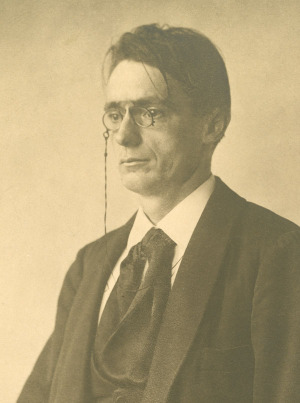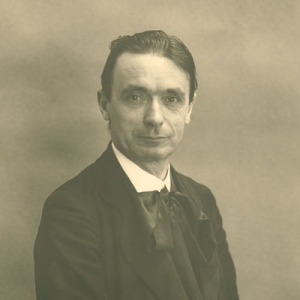Rudolf Steiner
Rudolf Steiner (1861-1925) was an Austrian philosopher, educationalist and visionary who once described his task as awakening the spiritual in the human being to the spiritual in the universe. But for Steiner there was essentially only one world – part seemingly hidden, part revealed.
As a child he was surrounded by the unspoiled landscape of Lower Austria and by railway trains – his father was a stationmaster; but what increasingly occupied his attention were what he called ‘the enigmas of existence’, and already at the age of fourteen he was reading the philosopher Emmanuel Kant. However, it was through the scientific writings of Goethe that the young Steiner finally found inspiration for his own unique path.
He studied at the Technical University in Vienna towards the end of the 19th century, and at the age of thirty was awarded a doctorate of philosophy from the University of Rostock. But it was to be another ten years before he found an audience, initially among members of the Theosophical Society in Berlin, interested to learn about his rich inner life of spiritual experiences – experiences which, he maintained, we are all capable of having, if – like him – we are prepared to do the requisite inner work.
For the last twenty years or so of his life he travelled all over Europe speaking to a wide variety of people who were looking for a deeper understanding of human existence and of the world in which they lived.
Almost a hundred years later Steiner’s work as a writer and lecturer continues to help and inspire people searching for renewal in all areas of human life – education, medicine, agriculture and the arts, as well as social and financial initiatives that place the needs and aspirations of the individual human being at the centre of decision-making.
 ‘Rudolf Steiner could see the world not just as it is or as it was, but as it could be; and that is a lonely path, a very lonely path’. These words were spoken to me by Dennis Klocek, a modern day alchemist working with Steiner’s indications in relation to agriculture, and a lecturer in Consciousness Studies at Rudolf Steiner College near Sacramento in California.
‘Rudolf Steiner could see the world not just as it is or as it was, but as it could be; and that is a lonely path, a very lonely path’. These words were spoken to me by Dennis Klocek, a modern day alchemist working with Steiner’s indications in relation to agriculture, and a lecturer in Consciousness Studies at Rudolf Steiner College near Sacramento in California.
My film is full of such helpful and sometimes challenging statements about the life and legacy of Rudolf Steiner. A biodynamic farmer on the east coast of the USA, Steffen Schneider, spoke of Steiner’s picture of agriculture as ‘something that would be valid for hundreds and hundreds of years’. The real challenge, he suggested, was not only to try and grasp what Steiner was talking about, ‘but to develop the insights and capacities to really see for oneself what he described’.
At an anthroposophical conference in Hyderabad, an Australian-based Englishman, Ben Cherry, who is helping to foster the Waldorf School movement in China and Taiwan, spoke of meeting the work of Rudolf Steiner as like finding water in the desert. ‘I had searched through many different paths’, he told me, ‘including the spiritual path of modern science’.
At Queens’College, Cambridge, the Revd Dr. Fraser Watts described what he saw as Steiner’s distinctive approach as wanting to address religious and spiritual questions scientifically. He went on to speak of ‘Steiner’s serious sense of purpose to leave the world a better place as a result of his mission …’ a mission characterised by this great outpouring of practical activities. It was a thought echoed by the President of the Biodynamic Association in India, ‘Jakes’ Jakarayan, whose farm we visited. ‘The beauty of Dr Rudolf Steiner’, he told me, ‘was that he was not just a philosopher living in a world of ideas, but that he brought all these ideas to practical human activity, whether it’s agriculture, education, medicine, or architecture’.
Among the doctors I spoke to at an international medical conference in Switzerland, at the Goetheanum in Dornach – Steiner’s base for the last ten years or so of his life – was Dr. Michael Evans, who runs courses in anthroposophic medicine for doctors in the UK, and in India and the Phillipines. His answer to my question – ‘What is unique about Steiner’s contribution to medicine?’ – was Steiner’s challenge to doctors ‘to think beyond the box.’ Steiner recognised what conventional medicine had to offer in relation to a detailed knowledge of the physical body, Evans went on, but what also needed to be recognised was that each person has a soul and a spiritual identity, and all that is part of being human, and all that is part of the process of becoming ill – and potentially can be mobilised in the healing process.
Another doctor, Ursula Flatters, working at the Vidar Clinic in Sweden, spoke to me about the importance she attaches to the biography of every patient in relation to their illness. We each have a story, she said, and sometimes that story is a secret story – even for the patient.
Dr. David McGavin spoke of the help of having what he called ‘Rudolf Steiner’s maps’ in his work with pain management at the Blackthorn Medical Centre in Kent. And a doctor from Chile, Carina Zeller, described to me her relief at finally finding a bridge between her deep interest in science and the importance she attached to spirituality.
In connection with the work for those with special needs that has spread all over the world as a result of Steiner’s lectures and writings, I visited two Camphill communities – one in England, and one in New England at Copake. There Penny Baring described to me her understanding of Steiner’s special contribution to this sort of work, in that a person with disabilities – like everyone else – will have further incarnations, and that what surrounds them now can help and even enrich their lives in the future.
The young baker at Copake, Joseph Papas – in response to my question about the danger of Steiner’s legacy becoming too isolated and even elitist – expressed the thought that although the biography of a Camphill community, like that of the individual, needed a certain separation for a time in order to grow and become strong, such a place perhaps now needed ‘to grow beyond its borders’.
On this same theme, Arthur Zajonc – Professor of Physics at Amherst College, Massachusetts – in response to my title ‘The Challenge of Rudolf Steiner’, suggested that one of the greatest challenges Steiner poses for us today is ‘the challenge that he lived with in his own lifetime – namely the challenge to battle against sectarianism’. A similar observation was made by Fraser Watts at Cambridge University in relation to the following that has built up around Steiner which can, he said, look rather cult-like. ‘Not at all what he wanted’, he added, ‘but it can look like that.’
There was certainly nothing cult-like about Phil Forder’s work at Parc Prison in South Wales, where he has run educational courses for eleven years; Phil was formerly a teacher in a Steiner Waldorf School. ‘For me one of the main things that Steiner brings’, he told me, ‘is that there is a lot more than meets the eye.’ A professor of philosophy and religion at the California Institute for Integral Studies, Jacob Sherman, echoed this thought when he acknowledged that Steiner’s work had opened up for him new possibilities that he hadn’t considered before.
Perhaps the most challenging statement in this respect came from the writer and publisher, Christopher Bamford.: ‘The essence of his message – and this is why it’s somewhat difficult to communicate – is that we already, here and now as we are, live in a spiritual world.’
Nonetheless Steiner had his feet firmly on the ground. For him spirit and matter were intertwined. Robert McDermott, editor of ‘The New Essential Steiner’, spoke to me about Steiner’s concern – particularly in the aftermath of the First World War – at what was happening politically, socially and economically. ‘He’s not a Marxist’, said McDermott, ‘but he drank from that cup … capitalism is a cruel system; so too is totalitarianism’. It was ‘an un-crual system’ that Steiner was looking for, in which the economic, political and cultural spheres would work collaboratively without any one taking over the other.
On this subject, the Chairman of the Executive Board of the Dutch-based Triodos Bank, Peter Blom, spoke to me about how Steiner always had the human being in the back of his mind, whether he was talking about economics, medicine or education.
This emphasis on the importance of the individual human being and where each one is coming from – their own unique story – underpins the whole Waldorf School movement. It’s what attracted Clarence Harvey, a teacher in mainstream secondary education in Liverpool, to join the Steiner Academy Hereford – the first Waldorf School in Britain to become state-funded, as yet without unacceptable strings attached. I looked at a similar initiative in the USA. The Washington Carver School near Sacramento is one of thirty Charter Schools in California alone that is introducing some of Steiner’s educational ideas.
At the Waldorf School in Washington DC, one of the teachers, Jack Petrash, emphasised the need for education not only to prepare children for what Clarence Harvey called ‘the external needs of society, important as many as these needs are’. Petrash expressed it as follows: ‘I feel children are going to need to ask questions that nobody is asking yet, in order to solve the world’s problems.’
‘Steiner was a realist and a very practical person’, was another of Penny Baring’s observations that she shared with me – ‘he saw that he was planting seeds for the future’. And in a Coffee House in Vienna a young NGO executive, Philippa Belcredi, described to me what she understood by Steiner’s main message: ‘He wanted us to stand up for our own ideas … He didn’t want us to follow him; he wanted us to follow ourselves.’ Dr Peter Selg expressed a similar thought: ‘The last thing Steiner wanted  to have was dependant people’. And on the same note the eurythmist, Margaretha Solstad, spoke to me about the challenge ‘to individualise what he has given’.
to have was dependant people’. And on the same note the eurythmist, Margaretha Solstad, spoke to me about the challenge ‘to individualise what he has given’.
I would only add that for me another essential aspect of Steiner’s message – a message that tries to communicate ancient wisdom in a form appropriate for modern consciousness – is that the world does have meaning and purpose, and that we are not alone, not just in our daily lives, but in the universe at large. Some listened, some not. Herein lay the challenge, both for him and now for us.
‘What’s unique about the work of Rudolf Steiner’, said Dennis Klocek, ‘is that it is not just a tradition. He threw down the glove and said you have to do something with this’.
Jonathan Stedall
For further information on Rudolf Steiner and Anthroposophy please click here:http://www.rudolfsteinerpress.com/pages/viewbook.php?isbn_in=9781855841635

